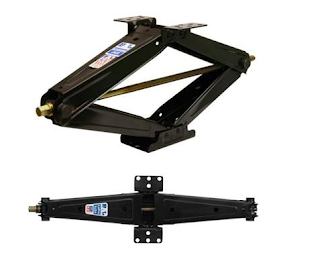Owning and living in your very own RV– no matter the size– can be an enriching and fulfilling experience, to say the very least. While this may be true, it is also true that in doing so, you have to consider all possible less-than-desirable situations as well– and be prepared for them.
Such situations can vary in severity, anywhere from keeping your RV stable while parked to handling leaks, flat tires, and even flooding. No matter what scenario arises, you need to be ready for it, which means you, therefore, need the right equipment on hand at all times.
Two examples of key pieces of equipment you need to satisfy both comfort and safety requirements are RV jacks, including leveling jacks and stabilizing jacks. While both of these items have the word “jack” within them, neither is a “jack of all trades” as these two are not interchangeable and cannot be used for every occasion that arises.
That being said, let’s take a look at both RV leveling jacks and stabilizing jacks, their uses, and other key specifications you need to know for both your safety and your rig’s!
What Are RV Leveling Jacks?
Leveling jacks are extremely important to any RV owner because they assist them in lifting and leveling their rig wherever it is parked, making them especially ideal when parked on uneven ground. Four leveling jacks are placed beneath your rig, one located at all four corners, and are meant to make your “mobile abode” level where you’d like it to be stationary.
These jacks are not only imperative for keeping your RV level but can even be necessary for ensuring some of your appliances continue operating.
Types of Leveling Jacks
Leveling jacks for RVs come in two types: manual and hydraulic. Hydraulic leveling jacks are the most convenient option among the two, especially for the much larger rigs. These work via an automatic system. Meanwhile, manual leveling jacks are the most cost-effective and reliable.
When Shouldn’t You Use a Leveling Jack?
Ultimately, these jacks should only be used for what their name suggests: to level your rig. These should not be used to stabilize your rig, as that is not what they are intended to do. However, it should be said that for the larger rigs particularly, their leveling jacks might also be stabilizers (if you have a larger rig, you should research and check if this is the case for you).
What Are RV Stabilizing Jacks?
RV stabilizing jacks are meant to reduce the amount of shaking and movement of your rig while you’re parked and walking around inside it. These are typically pre-installed into your RV’s frame and extend from there onto the ground. Most travel trailers are equipped with stabilizing jacks that have been installed in the frame.
Types of Stabilizing Jacks
Stabilizing jacks for your RV come in two configurations: manual (scissor) and electric. The manual or cross stabilizer jacks typically look similar to a scissor jack you’d use to change a tire on a car. These come with a manual handle that allows you to crank it up and down yourself.
Automatic stabilizing jacks work on their own to stabilize your RV for you. These are more convenient yet are typically slower than using a manual stabilizing jack.
When Shouldn’t You Use a Stabilizing Jack?
Your stabilizing jacks should only be used to stabilize your RV. They should absolutely never be used as levels! In fact, if you want to level your RV as you’re on uneven ground while also stabilizing it, you will need to use leveling jacks in tandem with your stabilizing jacks.
If you do use stabilizing jacks as levelers, be ready to cause severe damage to your RV’s frame and/or jacks.
You should also never use them in order to do mechanical work on your RV or to even change a tire. This is because these jacks are not made to lift your entire RV off the ground and that could, therefore, lead to dangerous outcomes.
A Final Note on Both Leveling and Stabilizing Jacks (and Chocking)
In certain scenarios, you may want to use the attributes of both RV leveling jacks and stabilizing jacks together. We recommend that you first level your rig, then stabilize it. If you can, we suggest adding a block of some kind beneath the footpads of either type of jack in order to disallow them from sinking into the ground (who wants to deal with mud and, ultimately, a shaky RV?).
When selecting either leveling or stabilizing jacks for your RV (which have not already been pre-installed), be sure to closely consider the weight of your RV as larger rigs require different jacks than smaller rigs.
You should also make sure to chock your wheels at any given opportunity when parked, regardless of if you use your leveling and/or stabilizing jacks. These are made to specifically keep your rig from (nightmarishly) rolling away. While stabilizing jacks can keep your RV stationary, too, who doesn’t love an extra layer of safety and peace of mind?
For all your RV accessories and needs, be sure to trust in us here at RV Upgrades. Give us a call or send us a text today at 866-332-7881 with any and all questions you may have!







